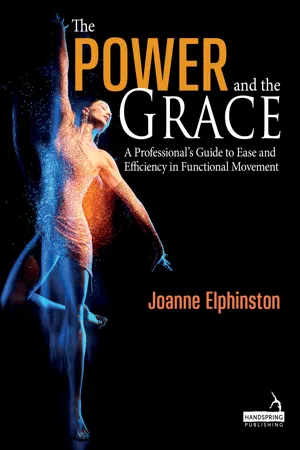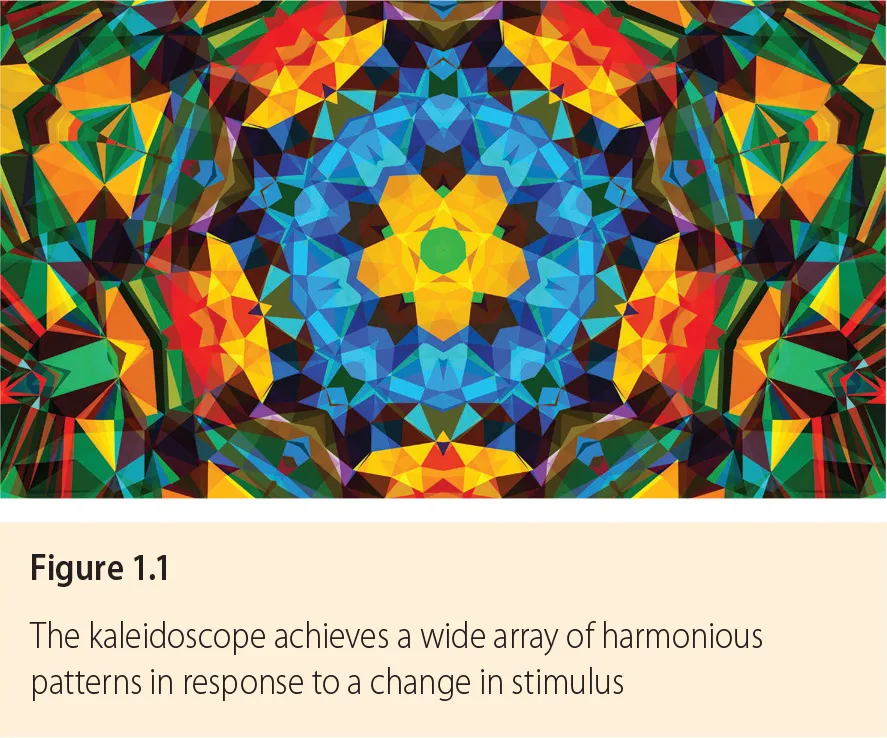
eBook - ePub
The Power and the Grace
A Professional's Guide to Ease and Efficiency in Functional Movement
Joanne Elphinston
This is a test
Compartir libro
- 264 páginas
- English
- ePUB (apto para móviles)
- Disponible en iOS y Android
eBook - ePub
The Power and the Grace
A Professional's Guide to Ease and Efficiency in Functional Movement
Joanne Elphinston
Detalles del libro
Vista previa del libro
Índice
Citas
Información del libro
Designed for Pilates and yoga teachers, health and rehabilitation professionals, ' The Powerand the Grace' demystifies functional movement and integrates the science of movementwith the art of teaching it. It aims to help the holistically minded movement professional achieve rewarding results in neuromuscular function. From brain science to physics, fascia to emotion, this book distilsa seemingly complex field into a practical and instantly usable approach that will resonatewith movement teachers at all levels of experience.Find the color in your language; learn the difference between talking to the brain or to the mind; and discover how to communicate the intention and sense of a movement with ease!
Preguntas frecuentes
¿Cómo cancelo mi suscripción?
¿Cómo descargo los libros?
Por el momento, todos nuestros libros ePub adaptables a dispositivos móviles se pueden descargar a través de la aplicación. La mayor parte de nuestros PDF también se puede descargar y ya estamos trabajando para que el resto también sea descargable. Obtén más información aquí.
¿En qué se diferencian los planes de precios?
Ambos planes te permiten acceder por completo a la biblioteca y a todas las funciones de Perlego. Las únicas diferencias son el precio y el período de suscripción: con el plan anual ahorrarás en torno a un 30 % en comparación con 12 meses de un plan mensual.
¿Qué es Perlego?
Somos un servicio de suscripción de libros de texto en línea que te permite acceder a toda una biblioteca en línea por menos de lo que cuesta un libro al mes. Con más de un millón de libros sobre más de 1000 categorías, ¡tenemos todo lo que necesitas! Obtén más información aquí.
¿Perlego ofrece la función de texto a voz?
Busca el símbolo de lectura en voz alta en tu próximo libro para ver si puedes escucharlo. La herramienta de lectura en voz alta lee el texto en voz alta por ti, resaltando el texto a medida que se lee. Puedes pausarla, acelerarla y ralentizarla. Obtén más información aquí.
¿Es The Power and the Grace un PDF/ePUB en línea?
Sí, puedes acceder a The Power and the Grace de Joanne Elphinston en formato PDF o ePUB, así como a otros libros populares de Medicina y Fisioterapia, medicina física y rehabilitación. Tenemos más de un millón de libros disponibles en nuestro catálogo para que explores.
Información
The movement kaleidoscope | 1 |
I am light, color, and endlessly shifting pattern, my fragments dancing with the kaleidoscope’s turn …
Imagine for a moment that your movement fits you like your favorite sweater. It is completely comfortable and completely expresses “you.” You feel that you can do anything in it: dress it up or dress it down, climb a mountain, or turn a cartwheel in it. You push your arms out into its sleeves and you are ready to go.
For movement to feel like this, many factors must play with one another. There is no single element that can transform a person’s movement into this very personal, harmonious, and effective expression of their intentions, drives, and desires. The body and brain together need a balanced diet of “movement nutrition” in order to flourish, and to explore the many physical and functional possibilities that we have as humans.
This integration of mind and body systems functions much like a kaleidoscope. Kaleidoscopes, humble sealed tubes containing a cascade of tiny glass pieces, create integrated and complex designs from the multicolored collection within it. A tiny twist of the kaleidoscope’s barrel changes the conditions, and a whole new design emerges that is as harmonious and coherent as the previous one. With another twist, the elements are reorganized again – the same elements are present, yet they offer a multitude of solutions. So it is with movement, where multiple processes within us work together to produce endless possibilities, ranging from extravagant forcefulness to dynamic stillness.

Instead of pieces of glass in a tube, we blend aspects of our thinking and emotional brains, our sensory and wider nervous system, and our musculoskeletal system to create patterns of movement to meet our daily needs and aspirations. We have a vast array of options available to us, but most of us display a mere fraction of our possible movement strategies. We are only turning our kaleidoscope through a few settings. As we shall see in later chapters, this is partly because our efficiency-driven brains streamline their activity by creating movement templates based on prediction and expectation. These become the habitual strategies that we reproduce in our daily lives, which saves on energy but narrows the variety and adaptability of our movement. This not only decreases our options, but tends to load our bodies in repetitive ways, and can contribute to eventual injury.
We don’t realize that we are using ourselves in repetitive patterns. In fact, most of us are unaware of how we move at all, unless stopped by pain or injury. We tend to assume that the way in which we move is a preprogrammed inevitability, but the strategies that we develop don’t just arise from our own physical warehouse of possibilities: they can be influenced by our environment, our jobs, our emotional state, and even the habits and posture of the people around us. Our histories are written in our movement and posture, but we can choose what our future holds when we become aware of the flexibility of the nervous system and our body’s capacity for change.
To achieve this, we need a change in attitude. When our movement strategies aren’t meeting our needs, we tend to think of them as errors to be corrected. This assumes only two options: right or wrong. This is not only incredibly limiting but highly inaccurate. You have many possibilities available, but you are expressing an edited version that has been pruned and shaped over time. If your movement habits aren’t what you would like them to be, the answer lies in unearthing and reconnecting with some of the other possibilities that have been dormant. People who move well have more settings on their kaleidoscope: they are able to access more combinations of factors, giving them many options and allowing them to respond and adapt to a wider range of movement challenges. Fundamentally, people who don’t move well have fewer options – they are often locked into their habits, which reduces their adaptability and loads their body’s structures more repetitively. If our bodies are able to move in different ways, they can choose the best one for the job.
It’s not about corrective exercise; it’s about opening up new options and making new choices.
For health throughout our life span, therefore, our focus for exercise, training, and movement is to develop a wider range of effective, sustainable, and adaptable movement strategies. We want to maintain the integrity of our body over a wide variety of activities and contexts, to be able to create and control forces efficiently, to readily adapt to the new or unexpected, and to do so with confidence and spontaneity. In other words, we want not only to access more settings on our kaleidoscope but to see more colors inside it. This is clearly going to demand more than mere muscle activation – it will involve the seamless integration of multiple factors.
This doesn’t have to be complicated. When we think of our daily diet, we understand that good health is supported by variety and balance. We are simply going to take the same approach to our movement.
The wheel of interdependence
The wheel of interdependence shown in Figure 1.2 is a simplified diagram, but it serves to illustrate just some of the many factors that influence and modify one another in the production of effective movement. At this point, some of the terms shown will be more familiar than others, but over the next few chapters, you will become comfortable with each one.
If you are willing to challenge yourself, look at this collection of factors and note whether you feel more attracted to some than others, or secretly believe that some hold greater significance. If you find that this is the case, it is a wonderful start, because if we can identify our biases, we can set about overcoming them. More rewarding results and a deeper understanding for both you and your clients become possible.

To appreciate the interplay of factors on the wheel, let’s select functional mobilityG as an example. Functional mobility is the ability to move freely and with control through the full range of motion required as you perform a dynamic activity. Functional mobility is only possible if you already have flexibilityG, as this is what gives us the potential for a range of motion. Having a potential range of motion, however, doesn’t mean that we can actually use it during movement, nor that we can control any flexibility gains that we achieve.
In order to meaningfully integrate the flexibility potential, we must have dissociationG, which is the ability to move our body segmentsG independently of one another. Keeping the pelvis in place as the rib cage turns into rotation is an example of this. Dissociation requires an appropriate pattern and level of muscle recruitment. If there is too much overall muscle recruitment, you cannot easily move one body segment away from another; instead they become fixed together, which makes you feel restricted.
Excessive muscle recruitment may be due to a number of physical or psychological factors. Selecting a task that is too advanced or heavy, trying too hard, or lacking confidence can all provoke this response. Let’s say, for example, that muscle tension is a reaction to a balance challenge. You start to wobble, and your senses tell you that there is too much movement, so you respond reflexively by contracting many muscles at once in an attempt to control the situation. This relatively immobilizes you, gluing your body parts together. If you attempt to move a limb with this process in play, you are thrown further off balance, as your muscles are working to resist the motion as you are trying to create it. You are pulling against yourself. You respond to this uncontrolled feeling by further increasing muscle tension, limiting your mobility even more. Your confidence becomes affected, your beliefs about your balance capability are reinforced, and above all you think to yourself that you really must do more stretching, because you don’t seem to be very flexible!
When the level of difficulty is too great, the “kaleidoscope” can become distorted, and effective, beautiful movement moves further from reach. Steady progression teaches the nervous system mastery rather than struggle.
We bounce from one part of the wheel to another as factors connect, either working for us or against us. It is easy for us ...